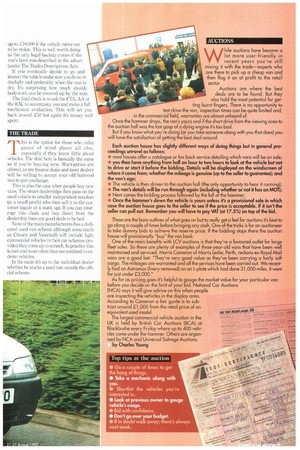AUCTIONS
Page 29

If you've noticed an error in this article please click here to report it so we can fix it.
hue auctions have become a lot more user-friendly in V V recent years you're still mixing it with the trade—experts who are there to pick up a cheap van and then flog it on at profit to the retail sector.
Auctions are where the best deals are to be found. But they also hold the most potential for getting burnt fingers. There is no opportunity to test-drive the van, inspection times can be quite limited and, in the commercial field, warranties are almost unheard of.
Once the hammer drops, the van's yours and if the short drive from the viewing area to the auction hall was the last gasp of a dying engine it's too bad. But if you know what you're doing (or you take someone along with you that does) you will have the satisfaction of getting the best deal around.
Each auction house has slightly different ways of doing things but in general proceedings unravel as follows: most houses offer a catalogue or fax back service detailing which vans will be an sale; you then have anything from half an hour to two hours to look at the vehicle but not to drive or start it before the bidding. Details will be displayed on the windscreen of where it came from; whether the mileage is genuine (up to the seller to guarantee); and the van's age; • The vehicle is then driven to the auction hall (the only opportunity to hear it running); • The van's details will be run through again (including whether or not it has an MOT); • Next comes the bidding process followed by the fall of the hammer; • Once the hammer's down the vehicle is yours unless it's a provisional sale in which case the auction house goes to the seller to see if the price is acceptable. If it isn't the seller can pull out. Remember you will have to pay VAT tat 17.5%) on top of the bid.
These are the bare outlines of what goes on but to really get a feel for auctions it's best to go along a couple of times before bringing any cash. One of the tricks is for an auctioneer to take dummy bids to achieve the reserve price. If the bidding stops there the auction house will provisionally "buy" the van back. One of the main benefits with LCV auctions is that they're a favoured outlet for large fleet sales. So there are plenty of examples of three-year-old vans that have been well maintained and serviced. Morris Cameron of Morris Leslie, Perth, reckons ex-Royal Mail vans are a good bet: "They're very good value as they've been carrying a fairly soft cargo. The mileages are warranted and all the services have been carried out. We recently had an Astramax (livery removed) on an L-plate which had done 31,000 miles. It went for lust under Z3,000." As far as pricing goes it's helpful to gauge the market value for your particular van before you decide on the limit of your bid. National Car Auctions (NCA) says it will give advice on this when people are ins ecting the vehicles in the display area.
According to Cameron a fair guide is to sub tract around 21,000 from the retail price of an
equivalent used model. INE ROAD paYe The largest commercial vehicle auction in the UK is held by British Car Auctions (BCA) at Blackbushe every Friday where up to 400 vehicles come under the hammer. Others are organised by NCA and Universal Salvage Auctions.
by Charles Young
































































































